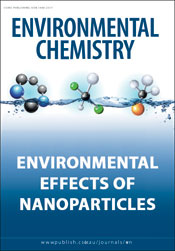
Environmental Chemistry
Volume 12 Number 6 2015
RESEARCH FRONT: Nano2014
EN14273Transformations that affect fate, form and bioavailability of inorganic nanoparticles in aquatic sediments
Environmental context. Engineered nanomaterials are increasingly being used and their release to the aquatic environment poses potential risk. We review the research on transformations of engineered nanomaterial in the aquatic environment, and consider the implications of their release. The key factors defining the fate of engineered nanomaterials in aqueous systems are identified.
EN15006A novel method for the quantification, characterisation and speciation of silver nanoparticles in earthworms exposed in soil
Environmental context. Increasing production and application of engineered nanoparticles has led to an increased potential for their environmental release, raising ecotoxicological concerns. To appropriately characterise the fate, effects and risks of engineered nanoparticles in environmental systems, methods are essential to characterise nanoparticles in complex biological matrices. This study reports a method that extracts nanoparticles from tissues of organisms, enabling their detection, quantification and characterisation.
EN14176Change in chirality of semiconducting single-walled carbon nanotubes can overcome anionic surfactant stabilisation: a systematic study of aggregation kinetics
Environmental context. Chirally enriched semiconducting single-walled carbon nanotubes (SWNTs) are some of the most utilised nanomaterials. Although chirality of SWNTs is known to influence their electronic properties and interfacial interaction, the interplay between chirality and surfactant structure in SWNT stability is not well understood. This study investigates these interactions, providing data to better assess the environmental fate of SWNTs.
EN15035Characterisation of bioaccumulation dynamics of three differently coated silver nanoparticles and aqueous silver in a simple freshwater food chain
Environmental context. Nanoparticles may be passed from primary producers to predators higher up the food chain, but little is currently known about this transfer. We studied the accumulation dynamics of silver nanoparticles by algae, and then from algae to zooplankton. Using the biodynamic approach, we reconstructed the accumulation process to show that diet is the primary route of uptake for silver nanoparticles.
EN15003Does natural organic matter increase the bioavailability of cerium dioxide nanoparticles to fish?
Environmental context. Nanoparticles are present in growing volumes of consumer products and are suspected to be released into the environment at detectable levels. We focus on cerium dioxide nanoparticles and investigate their availability to fish from the water column, where we found increasing concentrations of natural organic material increased the ceria measured in the fish gills. This complex interaction between nanoparticle behaviour and uptake from environmentally relevant test systems is significantly understudied.
EN14233Voltammetric tools for trace element speciation in fresh waters: methodologies, outcomes and future perspectives
Environmental context. Trace elements are ubiquitous in natural waters where their levels are highly variable depending on natural factors and anthropogenic pollution. The chemical form of the element determines its behaviour in the environment and whether it is likely to pose a risk to environmental and human health. This paper focuses on elemental forms in freshwater systems: it reviews analytical methods, gathers available data, and assesses trends, needs and open issues in this field.
EN15026Air pollution: new insight from direct measurements of ozone production
EN14094Phosphorus and arsenic distributions in a seasonally stratified, iron- and manganese-rich lake: microbiological and geochemical controls
Environmental context. Despite being present at trace concentrations, arsenic and phosphorus are among the most important of freshwater contaminants. This research highlights the biogeochemical coupling of both elements in a New Zealand lake. We find that the mineralisation of organic residues coupled to the dissolution of colloidal iron and manganese hydroxides may be an important driver of the bioavailability of phosphorus and arsenic.
EN14215Effect of fluctuating oxygen concentration on iron oxidation at the pelagic ferrocline of a meromictic lake
Environmental context. The cycling of iron plays an important role in pelagic boundary zones such as the oxic–anoxic interface where physical and chemical gradients occur. The turnover of iron in this zone depends on oxygen fluctuation and the duration of the fluctuation event. This study increases the understanding of biogeochemical iron transformation in such hotspots.
EN14157Interaction of humic acids with soil minerals: adsorption and surface aggregation induced by Ca2+
Environmental context. Humic acids, important components of natural organic matter in soils, sediments and aquatic media, can interact with the surface of minerals affecting key environmental processes. In the presence of calcium, humic acids can also interact among themselves leading to molecular aggregates. We demonstrate that a solid mineral surface facilitates the formation of humic acid aggregates, and thus surface aggregation occurs under conditions where normal aggregation in solution does not occur.
EN14223Dissolution of mixed amorphous–crystalline Cd-containing Fe coprecipitates in the presence of common organic ligands
Environmental context. Common soil minerals, which often contain trace metals in contaminated environments, are thought to limit metal-related risks in the environment. We studied the stability of these contaminated minerals and found that the presence of plant-derived organic compounds can alter contaminant availability in such environments. Understanding how soluble organics may change trace metal availability helps to predict risk and potentially remediate such environments more efficiently.



